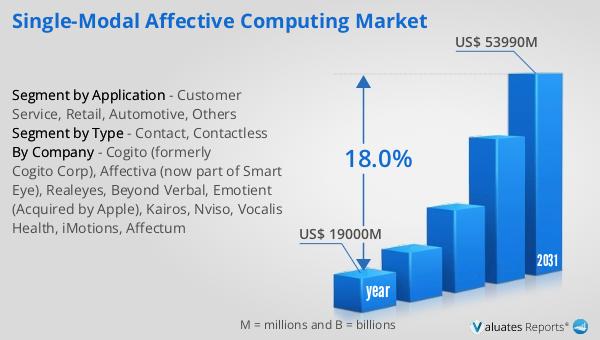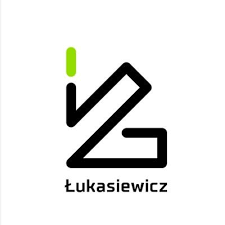List of Tables
Table 1. Global Single-Modal Affective Computing Market Size Growth Rate by Type (US$ Million): 2020 VS 2024 VS 2031
Table 2. Key Players of Contact
Table 3. Key Players of Contactless
Table 4. Global Single-Modal Affective Computing Market Size Growth by Application (US$ Million): 2020 VS 2024 VS 2031
Table 5. Global Single-Modal Affective Computing Market Size by Region (US$ Million): 2020 VS 2024 VS 2031
Table 6. Global Single-Modal Affective Computing Market Size by Region (2020-2025) & (US$ Million)
Table 7. Global Single-Modal Affective Computing Market Share by Region (2020-2025)
Table 8. Global Single-Modal Affective Computing Forecasted Market Size by Region (2026-2031) & (US$ Million)
Table 9. Global Single-Modal Affective Computing Market Share by Region (2026-2031)
Table 10. Single-Modal Affective Computing Market Trends
Table 11. Single-Modal Affective Computing Market Drivers
Table 12. Single-Modal Affective Computing Market Challenges
Table 13. Single-Modal Affective Computing Market Restraints
Table 14. Global Single-Modal Affective Computing Revenue by Players (2020-2025) & (US$ Million)
Table 15. Global Single-Modal Affective Computing Market Share by Players (2020-2025)
Table 16. Global Top Single-Modal Affective Computing Players by Company Type (Tier 1, Tier 2, and Tier 3) & (based on the Revenue in Single-Modal Affective Computing as of 2024)
Table 17. Ranking of Global Top Single-Modal Affective Computing Companies by Revenue (US$ Million) in 2024
Table 18. Global 5 Largest Players Market Share by Single-Modal Affective Computing Revenue (CR5 and HHI) & (2020-2025)
Table 19. Global Key Players of Single-Modal Affective Computing, Headquarters and Area Served
Table 20. Global Key Players of Single-Modal Affective Computing, Product and Application
Table 21. Global Key Players of Single-Modal Affective Computing, Date of Enter into This Industry
Table 22. Mergers & Acquisitions, Expansion Plans
Table 23. Global Single-Modal Affective Computing Market Size by Type (2020-2025) & (US$ Million)
Table 24. Global Single-Modal Affective Computing Revenue Market Share by Type (2020-2025)
Table 25. Global Single-Modal Affective Computing Forecasted Market Size by Type (2026-2031) & (US$ Million)
Table 26. Global Single-Modal Affective Computing Revenue Market Share by Type (2026-2031)
Table 27. Global Single-Modal Affective Computing Market Size by Application (2020-2025) & (US$ Million)
Table 28. Global Single-Modal Affective Computing Revenue Market Share by Application (2020-2025)
Table 29. Global Single-Modal Affective Computing Forecasted Market Size by Application (2026-2031) & (US$ Million)
Table 30. Global Single-Modal Affective Computing Revenue Market Share by Application (2026-2031)
Table 31. North America Single-Modal Affective Computing Market Size Growth Rate by Country (US$ Million): 2020 VS 2024 VS 2031
Table 32. North America Single-Modal Affective Computing Market Size by Country (2020-2025) & (US$ Million)
Table 33. North America Single-Modal Affective Computing Market Size by Country (2026-2031) & (US$ Million)
Table 34. Europe Single-Modal Affective Computing Market Size Growth Rate by Country (US$ Million): 2020 VS 2024 VS 2031
Table 35. Europe Single-Modal Affective Computing Market Size by Country (2020-2025) & (US$ Million)
Table 36. Europe Single-Modal Affective Computing Market Size by Country (2026-2031) & (US$ Million)
Table 37. Asia-Pacific Single-Modal Affective Computing Market Size Growth Rate by Region (US$ Million): 2020 VS 2024 VS 2031
Table 38. Asia-Pacific Single-Modal Affective Computing Market Size by Region (2020-2025) & (US$ Million)
Table 39. Asia-Pacific Single-Modal Affective Computing Market Size by Region (2026-2031) & (US$ Million)
Table 40. Latin America Single-Modal Affective Computing Market Size Growth Rate by Country (US$ Million): 2020 VS 2024 VS 2031
Table 41. Latin America Single-Modal Affective Computing Market Size by Country (2020-2025) & (US$ Million)
Table 42. Latin America Single-Modal Affective Computing Market Size by Country (2026-2031) & (US$ Million)
Table 43. Middle East & Africa Single-Modal Affective Computing Market Size Growth Rate by Country (US$ Million): 2020 VS 2024 VS 2031
Table 44. Middle East & Africa Single-Modal Affective Computing Market Size by Country (2020-2025) & (US$ Million)
Table 45. Middle East & Africa Single-Modal Affective Computing Market Size by Country (2026-2031) & (US$ Million)
Table 46. Cogito (formerly Cogito Corp) Company Details
Table 47. Cogito (formerly Cogito Corp) Business Overview
Table 48. Cogito (formerly Cogito Corp) Single-Modal Affective Computing Product
Table 49. Cogito (formerly Cogito Corp) Revenue in Single-Modal Affective Computing Business (2020-2025) & (US$ Million)
Table 50. Cogito (formerly Cogito Corp) Recent Development
Table 51. Affectiva (now part of Smart Eye) Company Details
Table 52. Affectiva (now part of Smart Eye) Business Overview
Table 53. Affectiva (now part of Smart Eye) Single-Modal Affective Computing Product
Table 54. Affectiva (now part of Smart Eye) Revenue in Single-Modal Affective Computing Business (2020-2025) & (US$ Million)
Table 55. Affectiva (now part of Smart Eye) Recent Development
Table 56. Realeyes Company Details
Table 57. Realeyes Business Overview
Table 58. Realeyes Single-Modal Affective Computing Product
Table 59. Realeyes Revenue in Single-Modal Affective Computing Business (2020-2025) & (US$ Million)
Table 60. Realeyes Recent Development
Table 61. Beyond Verbal Company Details
Table 62. Beyond Verbal Business Overview
Table 63. Beyond Verbal Single-Modal Affective Computing Product
Table 64. Beyond Verbal Revenue in Single-Modal Affective Computing Business (2020-2025) & (US$ Million)
Table 65. Beyond Verbal Recent Development
Table 66. Emotient (Acquired by Apple) Company Details
Table 67. Emotient (Acquired by Apple) Business Overview
Table 68. Emotient (Acquired by Apple) Single-Modal Affective Computing Product
Table 69. Emotient (Acquired by Apple) Revenue in Single-Modal Affective Computing Business (2020-2025) & (US$ Million)
Table 70. Emotient (Acquired by Apple) Recent Development
Table 71. Kairos Company Details
Table 72. Kairos Business Overview
Table 73. Kairos Single-Modal Affective Computing Product
Table 74. Kairos Revenue in Single-Modal Affective Computing Business (2020-2025) & (US$ Million)
Table 75. Kairos Recent Development
Table 76. Nviso Company Details
Table 77. Nviso Business Overview
Table 78. Nviso Single-Modal Affective Computing Product
Table 79. Nviso Revenue in Single-Modal Affective Computing Business (2020-2025) & (US$ Million)
Table 80. Nviso Recent Development
Table 81. Vocalis Health Company Details
Table 82. Vocalis Health Business Overview
Table 83. Vocalis Health Single-Modal Affective Computing Product
Table 84. Vocalis Health Revenue in Single-Modal Affective Computing Business (2020-2025) & (US$ Million)
Table 85. Vocalis Health Recent Development
Table 86. iMotions Company Details
Table 87. iMotions Business Overview
Table 88. iMotions Single-Modal Affective Computing Product
Table 89. iMotions Revenue in Single-Modal Affective Computing Business (2020-2025) & (US$ Million)
Table 90. iMotions Recent Development
Table 91. Affectum Company Details
Table 92. Affectum Business Overview
Table 93. Affectum Single-Modal Affective Computing Product
Table 94. Affectum Revenue in Single-Modal Affective Computing Business (2020-2025) & (US$ Million)
Table 95. Affectum Recent Development
Table 96. Research Programs/Design for This Report
Table 97. Key Data Information from Secondary Sources
Table 98. Key Data Information from Primary Sources
Table 99. Authors List of This Report
List of Figures
Figure 1. Single-Modal Affective Computing Picture
Figure 2. Global Single-Modal Affective Computing Market Size Comparison by Type (2020-2031) & (US$ Million)
Figure 3. Global Single-Modal Affective Computing Market Share by Type: 2024 VS 2031
Figure 4. Contact Features
Figure 5. Contactless Features
Figure 6. Global Single-Modal Affective Computing Market Size by Application (2020-2031) & (US$ Million)
Figure 7. Global Single-Modal Affective Computing Market Share by Application: 2024 VS 2031
Figure 8. Customer Service Case Studies
Figure 9. Retail Case Studies
Figure 10. Automotive Case Studies
Figure 11. Others Case Studies
Figure 12. Single-Modal Affective Computing Report Years Considered
Figure 13. Global Single-Modal Affective Computing Market Size (US$ Million), Year-over-Year: 2020-2031
Figure 14. Global Single-Modal Affective Computing Market Size, (US$ Million), 2020 VS 2024 VS 2031
Figure 15. Global Single-Modal Affective Computing Market Share by Region: 2024 VS 2031
Figure 16. Global Single-Modal Affective Computing Market Share by Players in 2024
Figure 17. Global Single-Modal Affective Computing Market Share by Company Type (Tier 1, Tier 2, and Tier 3)
Figure 18. The Top 10 and 5 Players Market Share by Single-Modal Affective Computing Revenue in 2024
Figure 19. North America Single-Modal Affective Computing Market Size YoY Growth (2020-2031) & (US$ Million)
Figure 20. North America Single-Modal Affective Computing Market Share by Country (2020-2031)
Figure 21. United States Single-Modal Affective Computing Market Size YoY Growth (2020-2031) & (US$ Million)
Figure 22. Canada Single-Modal Affective Computing Market Size YoY Growth (2020-2031) & (US$ Million)
Figure 23. Europe Single-Modal Affective Computing Market Size YoY Growth (2020-2031) & (US$ Million)
Figure 24. Europe Single-Modal Affective Computing Market Share by Country (2020-2031)
Figure 25. Germany Single-Modal Affective Computing Market Size YoY Growth (2020-2031) & (US$ Million)
Figure 26. France Single-Modal Affective Computing Market Size YoY Growth (2020-2031) & (US$ Million)
Figure 27. U.K. Single-Modal Affective Computing Market Size YoY Growth (2020-2031) & (US$ Million)
Figure 28. Italy Single-Modal Affective Computing Market Size YoY Growth (2020-2031) & (US$ Million)
Figure 29. Russia Single-Modal Affective Computing Market Size YoY Growth (2020-2031) & (US$ Million)
Figure 30. Nordic Countries Single-Modal Affective Computing Market Size YoY Growth (2020-2031) & (US$ Million)
Figure 31. Asia-Pacific Single-Modal Affective Computing Market Size YoY Growth (2020-2031) & (US$ Million)
Figure 32. Asia-Pacific Single-Modal Affective Computing Market Share by Region (2020-2031)
Figure 33. China Single-Modal Affective Computing Market Size YoY Growth (2020-2031) & (US$ Million)
Figure 34. Japan Single-Modal Affective Computing Market Size YoY Growth (2020-2031) & (US$ Million)
Figure 35. South Korea Single-Modal Affective Computing Market Size YoY Growth (2020-2031) & (US$ Million)
Figure 36. Southeast Asia Single-Modal Affective Computing Market Size YoY Growth (2020-2031) & (US$ Million)
Figure 37. India Single-Modal Affective Computing Market Size YoY Growth (2020-2031) & (US$ Million)
Figure 38. Australia Single-Modal Affective Computing Market Size YoY Growth (2020-2031) & (US$ Million)
Figure 39. Latin America Single-Modal Affective Computing Market Size YoY Growth (2020-2031) & (US$ Million)
Figure 40. Latin America Single-Modal Affective Computing Market Share by Country (2020-2031)
Figure 41. Mexico Single-Modal Affective Computing Market Size YoY Growth (2020-2031) & (US$ Million)
Figure 42. Brazil Single-Modal Affective Computing Market Size YoY Growth (2020-2031) & (US$ Million)
Figure 43. Middle East & Africa Single-Modal Affective Computing Market Size YoY Growth (2020-2031) & (US$ Million)
Figure 44. Middle East & Africa Single-Modal Affective Computing Market Share by Country (2020-2031)
Figure 45. Turkey Single-Modal Affective Computing Market Size YoY Growth (2020-2031) & (US$ Million)
Figure 46. Saudi Arabia Single-Modal Affective Computing Market Size YoY Growth (2020-2031) & (US$ Million)
Figure 47. UAE Single-Modal Affective Computing Market Size YoY Growth (2020-2031) & (US$ Million)
Figure 48. Cogito (formerly Cogito Corp) Revenue Growth Rate in Single-Modal Affective Computing Business (2020-2025)
Figure 49. Affectiva (now part of Smart Eye) Revenue Growth Rate in Single-Modal Affective Computing Business (2020-2025)
Figure 50. Realeyes Revenue Growth Rate in Single-Modal Affective Computing Business (2020-2025)
Figure 51. Beyond Verbal Revenue Growth Rate in Single-Modal Affective Computing Business (2020-2025)
Figure 52. Emotient (Acquired by Apple) Revenue Growth Rate in Single-Modal Affective Computing Business (2020-2025)
Figure 53. Kairos Revenue Growth Rate in Single-Modal Affective Computing Business (2020-2025)
Figure 54. Nviso Revenue Growth Rate in Single-Modal Affective Computing Business (2020-2025)
Figure 55. Vocalis Health Revenue Growth Rate in Single-Modal Affective Computing Business (2020-2025)
Figure 56. iMotions Revenue Growth Rate in Single-Modal Affective Computing Business (2020-2025)
Figure 57. Affectum Revenue Growth Rate in Single-Modal Affective Computing Business (2020-2025)
Figure 58. Bottom-up and Top-down Approaches for This Report
Figure 59. Data Triangulation
Figure 60. Key Executives Interviewed


